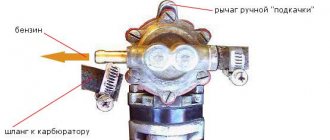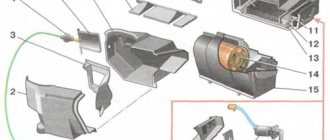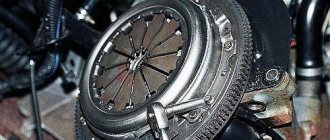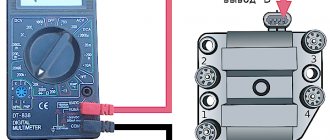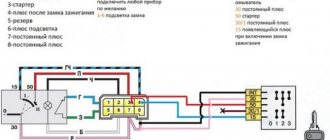3.8/5 — (63 votes)
You can delve a little deeper into history, since now we will talk about why the fuel pump does not work on a VAZ 2107 car. And the conversation will be about the carburetor engine. Consequently, the fuel pump is driven by a rod installed in the cylinder head. But first you need to consider the design of the device and understand what can fail.
Symptoms of a faulty fuel pump
Fuel pump for VAZ
Actually, these are rather two stages of the same malfunction, although it happens that malfunctions in the operation of the fuel pump do not lead to its complete failure. Especially when these failures are caused by some extraneous factors. And so, the fuel pump either simply fails or does not work at all. These are all his breakdowns. Another thing is that there are many breakdowns of other elements, which in their symptoms are very similar to fuel pump breakdowns.
As for the signs of a fuel pump malfunction, there can be a lot of them, and as already mentioned, they may coincide with symptoms of problems in other components and systems of the car. Therefore, we will describe only the most common and most characteristic of these symptoms.
- the car does not start or stalls frequently;
- engine troits;
- extraneous noise in engine operation;
- drop in engine power;
- absence of characteristic noise when the fuel pump operates;
The signs are very eloquent, but it’s not always possible to understand what they are talking about. And here we cannot do without methods for diagnosing the fuel pump.
Causes
There are several reasons why a VAZ fuel pump may not work:
- no power to the fuel pump;
- motor is faulty;
- pump is faulty.
Let me clarify some points. If the electric motor malfunctions, power is supplied to it, but if the brushes are broken, the rotor or windings are faulty, the motor will not spin and you will not hear a characteristic hum.
If the fuel pump malfunctions, a hum will be heard, but there will not be enough fuel or, in my case, the pump is simply jammed.
How to determine if a fuel pump is faulty
Be that as it may, most of the signs indicating a fuel pump malfunction may indicate problems in other systems and components of the machine. The car is malfunctioning - maybe the spark plugs, maybe the ignition, maybe some sensor is acting up. Extraneous noise in the engine can generally be caused by various breakdowns. Even when the engine stalls immediately after starting, you cannot blame only the fuel pump. For example, without readings from the crankshaft position sensor, the ECU can stop the pump, which is quite a normal car reaction to such a problem. And even a decrease in pressure in the system can be caused by leaks in the fuel lines, breakdown of the bypass valve and other failures.
What can you do right away? First of all, you can check the operation of the fuel pump before starting the engine. To do this, open the fuel tank cap and have someone turn on the ignition without turning the starter. In the first seconds after turning on the ignition, you should hear a specific noise from the fuel pump. If it is missing, most likely the pump will have to be replaced, although it is possible that the reason for the failure is the power supply to the device.
Measuring the pressure in the fuel rail is another way to check the fuel pump. Normal pressure readings, as well as the correct procedure for installing a pressure gauge, should be found in the documentation for your car.
Most often, in modern cars, when the fuel pump fails, it is replaced. But there is no need to rush into this. Perhaps the cause of the failure is not the fuel pump itself, but, for example, a coarse filter that is simply clogged. In this case, simply cleaning this mesh will help and you won’t need to change anything. It is also worth checking the wiring, fuse, as well as the fuel pump relay; perhaps the reason for the failure of the device lies here. Again, checking the fuel lines, the bypass valve, and even the injectors themselves will also not be superfluous.
The fuel pump does not pump..(
- Please log in to reply.
#21 alexdoc
- Users
- 1,965 messages
- Registration 04-March 09
- Top
- Complaint
it doesn’t pump manually or with the starter..( (there is gasoline in the tank).. the filter in front of the fuel pump is empty.. what could be wrong and how can it be fixed
First try to sip gas from the tank with your mouth. If you swallow it, then the problem is only in the pump; if you suck out the air, remove the sensor from the tank and see what’s there. If neither gas nor air flows, then
Fuel line clogged or clogged
#22 Edelweiss75
Message modified: Edelweiss75, 04 October 2013 - 06:48.
- Top
- Complaint
#23 Edelweiss75
- Top
- Complaint
#24 Yurec77
- From: Kyiv
- Auto: 21043/lanos.
- Top
- Complaint
#25 Navstar
- Top
- Complaint
#26 alexdoc
- Top
- Complaint
#27 vavanchik-h
- Top
- Complaint
#28 Visitor
- Top
- Complaint
#29 alexart
- From: Donetsk region
- Car: 2101,1977
Should the foot lift all the way up on its own?
Now she goes down with her finger and goes up quite a bit.
The return spring broke, this happens often.
Immediately after reassembly, I managed to manually pump gasoline a couple of times (you could see it in the filter), but then it stopped pumping again and the foot fell through.
Well, the pump won’t pump, the manual mode is for pumping after inactivity! Then it idles.
Do I need some kind of putty between the pump and the motor or is there just a gasket? when I separated it from the engine, it was not entirely clear what was there.
There are adjusting shims there, thick textolite, it's like heat-insulating, and cardboard, for adjusting the extension of the fuel pump drive rod.
Added after 2 minutes
The pumps on the classics are the same
I didn't thoroughly disassemble the pump.
- Top
- Complaint
#30 Visitor
- Top
- Complaint
#31 USSRMoto
- From: KiyoF
- Car: Subaru Forester SH 2009
The only thing cooler than black bekha is Lada
- Top
- Complaint
#32 Visitor
Visitor, it’s better to try with the car running. In manual mode, it will pump gasoline into the carb and will not pump any further, it seems.
- Top
- Complaint
#33 avtopeca
- Top
- Complaint
#34 BACCARA
Good afternoon! Same problem. In the morning you need to pump it up to start it. After driving, warmed up, turning it off, it won’t start until it cools down. The pump is a plunger pump. Even when it warms up, I give it speed, it chokes as if there is not enough fuel. Please advise. PS. Now I drive a classic.
the simplest thing is the valve.
- Top
- Complaint
#35 Visitor
Good afternoon! Same problem. In the morning you need to pump it up to start it. After driving, warmed up, turning it off, it won’t start until it cools down. The pump is a plunger pump. Even when it warms up, I give it speed, it chokes as if there is not enough fuel. Please advise. PS. Now I drive a classic.
- Top
- Complaint
#36 bars59
But gasoline remains in the float chamber (this is about a hot place).
- Like this: Sergey72
- Top
- Complaint
#37 Sergey72
Is it there? If the pump doesn’t pump up, then the chamber is practically empty. In the literal sense, you’re running on fumes. I'm already a nerd too. I understand everything, but I'm fucked up. The baker, his mother, in the cold pumps it up for beauty, it just warms up and begins to close and stall. I wet a rag with water, put it on top, for about 20 kilometers everything is OK. Today I went through the stock one, changed the valves, membranes, We'll see. In the store, a huckster with an important face says take a new Baker for 250 grams, it’s a plunger. And apparently I’ve never even heard of what a plunger is. What kind of plunger is there? The same valves and membrane, and only one, that is, in the event of a breakthrough, the gasoline will go into crankcase. The design of the valve head is simply changed and there is no tank in the upper part in which a vapor lock supposedly forms and the pump does not pump in the heat.
- Top
- Complaint
#38 ejik401
- From: Snow City
- Car: VAZ 2107 ZNG, Snow beige
Good day to all. I drive on gas, but in cold weather I warm up on gasoline. Once again, when I had to pump up gasoline, since the fuel filter was empty when switching to gas, I was faced with the fact that when pumping, I could hear air being sucked in and when the gasoline picks up, it leaks through the joint on the top cover of the fuel pump. The losses are, of course, small, but it takes quite a long time to pump gasoline and this creates inconvenience. Is there a cure for this gastrointestinal tract infection and how?
- Top
- Complaint
#39 July
- From: Ukraine
- Car: VAZ 2104, VAZ 2101
ejik401 , the gas pump should always be filled with gasoline, regardless of the type of fuel, the valve that closes gasoline should be located after the pump.
Remove the cover from the pump (10 mm wrench); under the cover there is a gasket with a mesh. Check all surfaces for scratches, flash and other irregularities.
- Top
- Complaint
#40 ejik401
- From: Snow City
- Car: VAZ 2107 ZNG, Snow beige
ejik401 , the gas pump should always be filled with gasoline, regardless of the type of fuel, the valve that closes gasoline should be located after the pump.
Remove the cover from the pump (10 mm wrench); under the cover there is a gasket with a mesh. Check all surfaces for scratches, flash and other irregularities.
sorted it out. I shook off the small debris (a couple of grains in total) and collected it. not leaking yet
Preventing fuel pump malfunctions
What should you pay attention to so that the fuel pump runs as long as possible? First of all, this is the quality of the fuel and, of course, timely replacement of the fuel filter. If the gasoline you fill contains various foreign inclusions, this will most likely negatively affect the condition and service life of the fuel pump, and not only it. Therefore, it is not worth saving on the quality of fuel, since such savings then result in very significant expenses for car repairs.
Lada 2106 2001 - self-repair
Comments 8
Participate in the discussion can only registered users.
The problem of gasoline evaporation and the formation of an air lock in the gasoline pump lies in the design of the gasoline pump itself. In the DAAZ there is a “parasitic” volume in the hemispherical lid, which serves as a catalyst for the formation of a plug, but in the baker there is no such volume, and the filter itself is mounted in the inlet fitting of the pump, but the baker has only one diaphragm and there is no safety fuel discharge in case of a membrane break.
mm interesting, but sometimes you also get up, the fuel pump heats up and you spray it with water, you wait and then you drive on)
I don’t agree about Pekar. It’s been working for about five years now and I don’t know any problems with it, the only drawback is that the outlet fitting is poorly flared, and it has never failed in any heat or cold! And such b.n. with round lids I changed a lot until I got tired of throwing away money. Almost everyone had problems in the heat, many had membranes leaking after a short period of use. With the Baker I forgot about all these shortcomings, only with a normal Baker, and not a Chinese ga.n!
Then you were lucky with Pekar, but I came across China twice :/
There was a lot of China on the market then and even more so now. It’s not difficult to distinguish between a normal one and a Chinese one, it’s very noticeable by the casting and coloring of the case, at least five years ago I bought it that way.
Interesting, this is the first time I’ve seen such a system, I’ve mostly only heard it in words. Is it working fine at the moment? On what principle is the return line built?
So far everything is amazing with this system. The car runs on gas-gasoline. During the transition to gas, the pump turns off automatically so as not to run idle, and when gasoline is turned on, it also automatically starts pumping. freed from constantly being under the hood for manual pumping. return from the Solex carburetor to the tee in front of the filter.
Full version of the site
Where is the VAZ 2107 fuel pump located?
Depending on the type of engine power supply, the location of the fuel pump also changes. Moreover, carburetor “sevens” have conventional mechanical pumps. They are installed in the engine compartment, on the side of the cylinder block. A distinctive feature is the presence of a manual drive lever.
The photo shows a VAZ 2107, the problem unit of which is the fuel pump
Fuel line hoses are connected to the unit on both sides. But owners of injection Ladas should look for the fuel pump in the rear of the car. More precisely, the electric pump is located directly in the fuel tank, which, in turn, is fixed in the area of the right rear fender, under the trunk trim.
How to check the fuel pump (carburetor) for malfunctions:
- Loosen the clamp and remove the hose supplying fuel to the carburetor from the fitting.
- To prevent gasoline from flowing out of the hose, plug it with a pre-prepared M8 bolt.
- Pump the hand drive lever several times.
- A strong stream of fuel should shoot out of the outlet fitting. If so, the pump is working. Otherwise, continue checking.
- Loosen the clamp, remove the second hose and plug it in the same way as the first.
- Cover the inlet fitting with your finger and swing the lever a couple of times. You should feel a vacuum, that is, your finger seems to be sucked into the hole. If suction is present, the fuel line must be checked. If the finger is not sucked in, you need to replace the pump or repair it.
Video about fuel pump malfunctions
Replacement:
- Using a metal brush, WD-40 (or white spirit), clean the area where the pump meets the cylinder block.
- Disconnect and plug both hoses with M8 bolts.
- Using a 13 mm wrench, unscrew the two fastening nuts.
- Remove the fuel pump from the studs.
- Install the new pump in reverse order.
The fuel pump works, but does not pump gasoline, the main causes of failure
One of the most important elements of the fuel injection system of a gasoline engine is the electric fuel pump, which is located in the fuel tank of the car.
The fuel pump pumps fuel into the system from the gas tank, creating a certain pressure. Auto repair experts identify the following common fuel system problems that are related to the fuel pump:
- The fuel pump pumps poorly and does not create the required pressure;
- the fuel pump does not pump when the ignition is turned on;
Considering that the fuel pump is an electromechanical device, the most common fuel pump malfunctions are related to both the mechanical and electrical parts. Next, we will look at what signs indicate a breakdown of the fuel pump and why the fuel pump stops pumping partially or completely.
Repair
The first step is to check the gasket between the pump housing and the insulating spacer. Its thickness must be at least 0.3 mm. The second gasket, between the spacer and the cylinder block, with a thickness of 0.8 mm, may also require replacement.
Between the heat-insulating spacer and the fuel pump body there should be a gasket 0.3 mm thick
If the car has a mileage of more than 100 thousand km, it is necessary to measure the amount of protrusion of the pusher. To do this, both gaskets are installed between the spacer and the cylinder block. You need to press the spacer tightly and, slowly turning the crankshaft, use a caliper to measure how much the pusher protrudes in the extreme position. The numbers should be in the range of 0.8-1.3 mm. Otherwise, replace the 0.8 mm shim with a thicker one, for example 1.25 mm (if the protrusion is greater than 1.3 mm), or a thinner one (if the pusher does not protrude enough). The store specifically sells a repair kit for this purpose with different gaskets. You can also cut the gasket yourself from poronite.
How to change the diaphragm and rod
The most common cause of fuel pump failure is the destruction of the working diaphragm. Replacing it is easy. To do this, remove the top cover and remove the diaphragm assembly. The DAAZ pump has three diaphragms installed. To replace them, the rod nut is unscrewed. If necessary, the rod itself is changed. The Pekar pump has only one diaphragm. To remove it, it must be rotated 90º. Additionally, when replacing the diaphragm, it is recommended to pay attention to the spring. If it breaks, it needs replacement.
Cleaning and checking parts
Now let's start cleaning and checking. It is best to thoroughly rinse everything with kerosene and dry it; you can also use an ultrasonic cleaner. It is important to get rid of dirt that hides possible damage and can interfere with the operation of the pump.
We carefully monitor every part:
- strainer - if there are no cracks, there are no larger holes - the mesh must be uniform for proper operation;
- sump glass - cracked or cracked - such defects entitle you to replacement;
- valves - they should not have signs of wear on the contact surface of the elements - it is best to wash them well, dry them and check them by putting them in your mouth and blowing on both sides - blowing on one side should not allow air to pass through, and on the other hand the pressure should cause the valve to open and flow - if it is not there, the valves should be replaced with new ones. For dismountable valves where minimal wear is visible, laminate or bakelite tiles can be repaired by sanding them down with a smooth sheet of fine sandpaper. In addition, of course, you cannot break the valve springs.
- membrane - must be elastic, without cracks or signs of old age. Abrasions on the edge of the bolt holes also indicate that it is time to change it - due to overstrain, it can quickly burst.
- lever and diaphragm arm - at the points of contact of the arm with the diaphragm cable and the lever with the cam, the material consumption should not exceed 0.5 mm. The wear of the bushing, axle and lever hole is shown in the table below - if they exceed the permissible value, contact a lathe who will pull out a new bushing and pin;
- Springs - Both the lever spring and the diaphragm spring should be free of cracks, corrosion or wear.
How to check the relay and fuse of the fuel pump (injector)
Unlike the good old carburetor VAZs, on the injection 2107 the fuel pump is electric and its operation can be heard when you turn the ignition key. If you don’t hear the usual buzzing one morning, the first thing you need to do is check the corresponding relays and fuse. The mounting bracket with the required elements is located under the front panel, in the area of the glove box. There are three relays and the same number of fuses installed there.
The operation of the fuel pump on the injection VAZ 2107 can be heard when you turn the ignition key
First, inspect fuse F3 (third from left) for blown fuse. It is quite possible that this is the issue. If necessary, replace the fuse with a whole one. The fuel pump relay is in the middle, that is, R2. Measure the voltage between the pink wire going to the relay and the body negative with the ignition on (when the pump should be running). If there is 12 volts, connect the pink wire to the gray wire (with the ignition on). In this way, contacts 30 and 87 of the relay are connected. If the pump starts working, then the relay is faulty. To ensure correct judgment, it is recommended to temporarily install a known working relay from another car. When the pump continues to be inactive, you need to check the electrical wiring to the pump block and, if necessary, change the device itself. It would also be a good idea to check the ground of the electric pump, which is mounted in the trunk area.
How to replace the coarse filter on an electric pump:
- Depressurize the power system. To do this, you need to remove the fuel pump fuse F3 and start the engine so that it uses up the fuel supply in the pipe.
- Disconnect the ground on the battery.
- Using a Phillips screwdriver, unscrew the four screws that secure the fuel tank trim in the trunk. Remove the trim.
- Using a 10mm wrench, unscrew the clamp bolt and release the tank, thereby providing access to the pump.
If the car engine does not start, then various factors can be the reasons for such consequences. One of these factors may be a gas pump, the main purpose of which is to pump gasoline into the engine from the gas tank. The VAZ 2107 has an injector and a fuel pump that is much more reliable than on carburetor cars. Despite this, even on fuel-injected cars the fuel pump can fail.
Power check
You can establish the presence of voltage at the TN connector using a simple test to check electrical circuits. To check the fuel pump, in the electrical diagrams for your car model, find the pinout of the electrical connector of the fuel module. For the pump motor to operate, “–” and “+” are required. If, after turning on the ignition and connecting the control contacts to the corresponding pins of the block, the light comes on, then everything is in order with the supply voltage. Using this method, you can check for the presence of +12V and ground in the fuel pump relay connector, and establish the presence of supply voltage from the ECM to the relay. If the fuel pump does not turn on, but there are no problems with the components of the electrical circuit, the reason is in the fuel pump itself.
The most convenient way to determine why there is no power to the fuel pump is to use a multimeter. Let's say that + 12V to the pump comes from the relay, but does not reach the fuel module connector. In this case, it is necessary to ring the wires from the relay to the fuel section. In ohmmeter mode, you will not only find an open, but you will also be able to see the parasitic resistance in the circuit. When considering possible reasons why the fuel pump does not pump, do not forget about the immobilizer failure. Often in such cases the engine starts, but stalls after a few seconds.
What is the device in question?
The fuel pump on the VAZ 2107 injector is presented in the form of an electric motor with a pump, which pumps gasoline from the tank.
The pump design has an electric motor that is powered from a 12V vehicle network. The design of the electric motor consists of a rotor, brushes and a commutator, which are constantly in gasoline. Many will think that such an injector power system for the VAZ-2107 car is quite dangerous, but not everything is so simple.
Spark and gasoline are a dangerous compound that can lead not only to fire, but also to explosion. This would happen, because sparking occurs in the electric motor of the gasoline pump, if not for the fact that gasoline belongs to the category of liquids that do not conduct electric current. In addition, gasoline does not burn if there is no air, and the fuel circuit is exclusively closed. Thus, the design of an electric fuel pump on a VAZ 2107 car is presented.
Car owners find out where the VAZ 2107 injector fuel pump is located only when there is a suspicion that it is faulty. On carburetor sevens, this device is located in the engine compartment near the engine. Many may think that this device is located there on injection sevens, but no. The device is located directly in the car’s gas tank, which simplifies the fuel pumping system. If you open the trunk and lift the carpet, you can see its outlet pipes. This arrangement of the device in question simplified the process of pumping fuel, but thereby complicated access and replacement of the product when it fails.
The principle of operation of the device is quite simple. After turning the ignition key, power is supplied to the electric motor terminals, causing the pump to pump gasoline into the system until a certain pressure is created. When the pressure has been created, the engine can be started. When the engine starts, the fuel pump continues to function throughout the entire period of engine operation, while maintaining pressure in the fuel system. After the engine is turned off, the pressure in the system remains for some time for several minutes, after which, if the engine does not restart, it decreases.
Theory
The fuel pump, mechanically driven by the camshaft (or by changing the pressure in the push-pull crank chamber), moves a lever connected to the pump diaphragm. The diaphragm, moving down, sucks fuel from the tank through the valve, after which the spring returns the diaphragm to its original position, as a result of which the sucked fuel is pushed through the second valve into the carburetor.
Thus, the suction stroke of the pump is determined by the movement of the lever driven by the cam, while the discharge stroke is determined by the spring compressed during suction. These types of pumps are also equipped with a lever for manual pumping, for example after a long stop and fuel has leaked from the pump. To avoid having to crank the starter for a long time, simply use the lever and prime the carburetor float chamber by hand.
Typically, the fuel pump sump is equipped with a simple fuel filter - a dense mesh built into the top of the suction channel. The gasoline, before it enters the valve, is in a sump and only when it reaches the overflow level does it enter the suction valve channel. This pump design allows thicker impurities to settle at the bottom of the sump, and smaller ones to settle on the pump filter. However, this type of filter is often insufficient, so it is worth installing a flow-through filter on the hose and forget about problems with dirty fuel.
The second option differs in that the unregulated pressure control valve remains in the open position, which causes the pump chamber to become leaky; in order for the controller to start the pumping process, it must close the valve by controlling it.
Only when the chamber is sealed does the pressure increase due to the decrease in chamber volume. Fuel will flow to the high pressure side when the exhaust valve opens, and this occurs when the pressure in the chamber is higher than the main pressure. When during the pressing phase we reach the appropriate pressure in the main line, the controller turns off the flow control valve, which causes the chamber to unseal and thus ends the pressing process and the fuel from the chamber flows to the low pressure side.
The pressure then drops and the outlet valve closes due to the pressure difference. This concept also allows only the required amount of fuel to be compressed, although from the control side it is clear that the opposite is true. This concept is also rectangular in shape, and its frequency is equal to the stroke frequency of the piston, and a decrease in duty cycle under conditions of increasing rotation speed does not necessarily mean a decrease in pump flow, since the piston travels the same path, albeit in a shorter time.



